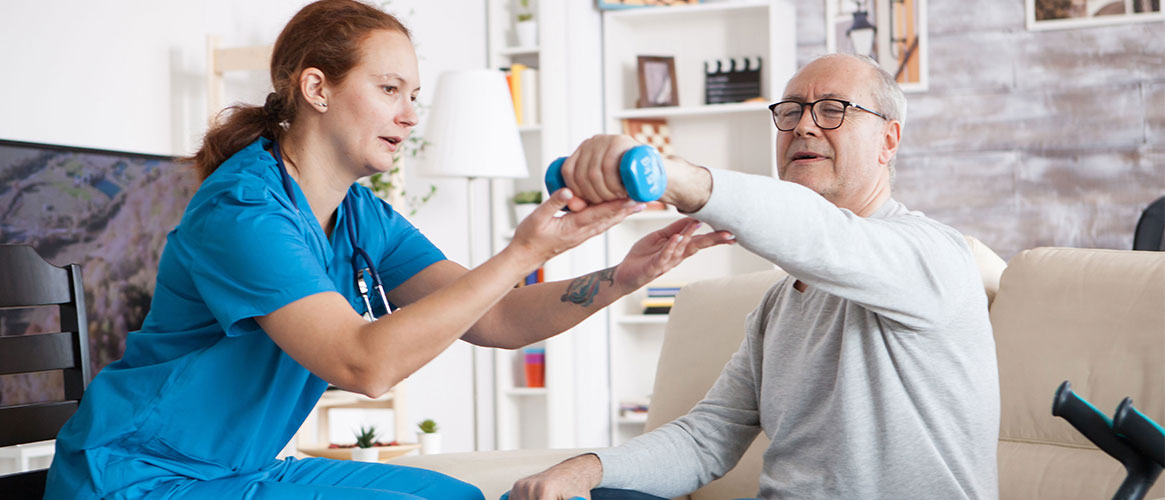Home healthcare is a fast growing industry. It can be challenging for those who provide patient care because the workplace isn’t a hospital or clinic, but rather a person’s home. Because of the ever-changing work environment, it is important for these caregivers to be aware of the hazards they will encounter on the job.
Ergonomics
One of the main concerns for in-home caregivers are musculoskeletal injuries. These include sprains or strains, resulting from improper patient handling. Tasks like transferring, bathing, and dressing patients can contribute to musculoskeletal disorders when completed incorrectly. Patients may be overweight, unresponsive, combative, or otherwise limited in mobility. Rooms in a client’s home may be small with non-adjustable beds.
Here are a few tips to help reduce the likelihood of musculoskeletal injuries:
- Assess the patient’s home to determine if the correct equipment is in place to assist with lifting or adjusting. (If the equipment is not available, communicate with the patient’s physician who will then order the equipment and bill the patient’s insurance).
- Use proper body mechanics; keeping the patient and the lift close to the caregiver reduces excessive forces.
- Maintain the curve in the low back by bending forward at the hips and use the legs to power the lift.
All in-home caregivers should receive training on correct patient transfers along with proper use of lift equipment.
Infection control
Preventing the spread of infections, helps protect both the caregiver and the patient. To assist with proper protection, caregivers should:
- Be informed of the patient’s health condition.
- Always follow standard precautions. Treat all sharps, blood, and other bodily fluids as if they are contaminated.
- Wear latex or nitrile gloves and proper personal protective equipment (PPE) at all times when handling patients and their body fluids. This helps prevent contamination.
- Watch for symptoms of airborne diseases and wear respiratory protection if necessary.
- If there is a known infectious agent, follow transmission-based precautions to prevent contact, droplet, and airborne disease transmission.
- Wash hands frequently.
Sharps hazards
Needlesticks are a hazard for homecare workers. Family members and patients may not properly dispose of needles and other sharps in the home environment after administering medication. This leaves syringes and lancets exposed. Inspect work areas carefully to avoid accidental sticks.
Other steps to take include:
- Consider using needleless devices, shields, or other safety equipment.
- Ensure that a sharps disposal container is available at the home for any used sharps.
- Never recap a needle, break it, or tamp down garbage.
- Ensure all employees receive training in bloodborne pathogens and needle stick prevention.
- Report all sharps or needle stick injuries to a supervisor immediately. Record these injuries on the sharps injury log and provide follow-up care.
Personal safety
Visiting patients in the community, entering private homes, and handling patients with behavior problems can put an employee at risk.
- Ensure all employees receive training on how to handle violent and unpredictable behavior.
- Ensure caregivers maintain communication and share their location with the “home office” at all times.
- Have employees’ program local emergency numbers such as 9-1-1 and poison control, into their cell phone and keep it handy at all times.
- Ensure employees do not to enter a home that has unsecured weapons, aggressive animals, or other security threats.
In-home caregivers are a growing and critical component of our healthcare system. Their safety and health is as critical as the patients they care for. Working in multiple, ever-changing environments each day, home healthcare providers have no control over the work environment. Unsanitary or unsafe conditions can increase their risk for injury. Talk to your employees today about the hazards they need to avoid. Increasing awareness through regular communication about safety reduces the likelihood of injury.
(Rev. 11/2023)
